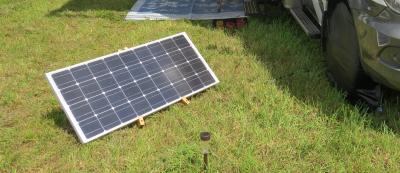DIY RV Solar Install
 I've read a few articles and blogs about solar installs on RV's and it's always intrigued me. But I had never talked to anyone first hand about their set-up/experience. This past spring I had the chance to do that and it was vary helpful. While in Arizona this past spring, I met a fellow RVer who had a 200 watt solar set up on the roof of his Leisure Travel Unity class B+ (very similar to my Winnebago View). When I asked him about it, he told me he had been able to go 2 weeks on two 12V batteries without having to run his generator or be plugged in. This sounded real appealing.
I've read a few articles and blogs about solar installs on RV's and it's always intrigued me. But I had never talked to anyone first hand about their set-up/experience. This past spring I had the chance to do that and it was vary helpful. While in Arizona this past spring, I met a fellow RVer who had a 200 watt solar set up on the roof of his Leisure Travel Unity class B+ (very similar to my Winnebago View). When I asked him about it, he told me he had been able to go 2 weeks on two 12V batteries without having to run his generator or be plugged in. This sounded real appealing.
My Winnebago View has two 12V batteries and I can easily go a day or maybe two without having to recharge them. When traveling each day the recharge is not an issue because driving recharges them from the vehicles alternator. But when stay put camping without hookups, I have to run my generator for about 60-90 minutes each day to recharge them. My generator runs on propane and it will go thru about .6 gallons an hour. My 13 gallon propane tank would carry me for about 2 weeks if it was full and I wasn't using anything else. But, its never always full and when parked I use propane for the frig, hot water, sometime heat, and cooking so my 2 weeks is not realistic. Its more like a week.
But the biggest drawback is the noise. The generator is noisy and you can't always run it in some places. I get a little self conscious when running it especially when in a pristine nature setting with camping neighbors. Who wants to listen to a noisy generator.
So after talking with the guy in Arizona about his setup, I began to feel that a solar set up would be a good thing to add to my RV. However, there are no RV solar installers near where I live. But I'm a pretty handy guy, so I began researching it to see if I could do it myself.
The Internet has a ton of info and vendors selling solar setups for RVs. And the prices for the equipment are all over the place. But thank God for YouTube, blogs, discussion groups, and user groups. I got to benefit from a lot of other peoples experiences and could ask them questions. So, here's what I figured out for my rig. The figures I use a ball park estimates, but good enough for me to design a setup.
- A general rule of thumb is to install 100 watts of solar for every 100 amp hrs of battery capacity. A 12V or 6V battery can delivery around 85-100 amp hrs (some do more, some do less) so for my two 12V batteries, 200 watts of solar should be sufficient.
- Daily DC usage is key to sizing what you need for batteries and solar. Every one's usage is different. My daily usage for lighting, the water pump, frig panel, alarms, and heater fan is about 50-75 amp hrs per day. This means that I go thru about 25-40% of my battery capacity each day when I'm parked. Add some TV watching, radio listening, phone charging, a compressor frig, and you'll go thru more.
- A 100 watt solar panel will produce around 5 amps of power per hour in perfect conditions. Plan on 5-6 good hours of sun and you're looking at getting 25-30 amps hrs from a 100 watt panel. Two 100 watt panels will double that to 50-60 amps hrs.
- You need a charge controller to use with solar panels to safely and effectively charge the batteries. Controllers are sized based on how many amps they can handle. For two 100 watt panels, a 20 amp controller is sufficient. Also, there are two types; MPPT and PWM. MPPT controllers are "smarter" and more effective in larger installs (over 400 watts). They are also more expensive (around $200). PWM controllers are simple and very effective for smaller installs (under 400 watts). They are also less expensive (under $100).
- You need to know the size of everything and figure out where everything will go before you order anything or start. Where on the roof, how to secure, where to run the cables, where to install the controller?
- Other things you need to install solar - mounts for putting the solar panel(s) on the roof, a way to attach the panels to the roof (screws or adhesive), caulking to plug and waterproof any holes, cable and connectors to connect the panels to each other and to the controller, cables and connectors to connect the controller to the battery, cable ties and tie bases to secure the cables, and fuse links to put on the cables for safety.
A key dilemma that influenced how I planned my install and what I ended up acquiring was how to run the cables from the solar panels down to the charge controller. I have a fiberglass roof on my RV and no entry point that I could use on the roof to run a cable. I really didn't want to drill a hole in the roof. I had read that a properly pointed panel is much more efficient than a flat horizontal panel. My intended use for the solar is when I dry camp at music festivals - which is about 3-4 times per year. I decided to install everything to support two 100 watt panels, but to start out with one free standing panel that I could build a stand for and point it properly. I'd permanently install the charge controller and wire it to the battery and build a pig tail so I could plug a portable panel into it when I wanted to use solar charging. I knew that one panel probably wouldn't fully recharge my batteries, but it might buy me an extra day. Also, I figured this was way of minimizing cost, I could see how it works, and for another $150 I could always add another panel and mount them on the roof at a later time.
So, here's what I purchased
- From Renogy - a 30 amp PWM charge controller with a temp sensor, one 100 watt mono-crystalline panel, 20 ft of 10g wire, and a MC4 connector tool.
- From Amazon - 25 ft split loom cable housing, cable ties and mounts.
- From PowerWerx - four Anderson SB50 Powerpole connectors with dust covers, two in line fuses, and a crimper.
- From Lowes - misc connectors, wire, grommets,
- Total cost - $344.
I installed the charge controller in a storage compartment right near the coach batteries. I ran two 10 gauge wires (about 4 feet) from the storage compartment to the battery bank with an in line fuse on the positive line and connected them with ring terminals. I had to drill a 1/2 in hole in the storage compartment wall to get the wires out and used a rubber grommet to protect the wires. I put a disconnect on these wires so I could easily disconnect from the batteries. The charge controller has a parasitic draw of less than 30 mill. amps and I wanted to avoid this draw when I wasn't using the solar panel. I wrapped these cables with heat resistant split loom and secured the cables with zip ties to an existing cable. I made a short pig tail cable to connect to the solar connectors on the charge controller. I put an in line fuse on this wire and used a Anderson SB50 power pole connector on the end. I used the 20 ft 10 ga cable from Renogy that had MC4 connectors on one end to connect to the solar panels and put another Anderson SB50 Powerpole on the end to connect to the pigtail cable on the controller.
Here are some pictures of the install.
Charge controller
100 watt solar panel (47 in x 21 in)
Home made easel to hold panel
And the $64,000 question - how does it work?
I first tested the set up on my 12V lawn tractor battery to make sure everything worked (i.e., that it would actually charge the battery and not "fry it"). Everything worked as advertised. I then hooked it up to my RV batteries and it worked perfectly. The charge controller accurately read my battery voltage and the panel was able to putout close to 20V and 5-6 amps in clear sun. It dropped down to 2-3 amps in party cloudy conditions. When the batteries where fully charged, it dropped down to float charging mode putting out .2 amps.
The solar panel fits in my rear storage compartment with all the other stuff so it will be easy carry with me when I need it. The easel I made breaks down and that also fits in the storage compartment.
I had a chance to test this all out while dry camping at a recent music festival. I had perfect sunny weather for 5 days. My electrical usage was minimal - I only used some lights, radio, the water pump, and the normal alarms/monitors. The panel kept my batteries fully charged during each day. Since it was free standing, I could easily move it around and get full sun on the panel. I only needed to run the generator when I wanted the use the microwave or run the A/C.
I am very pleased with my setup. I like the flexibility of having it free standing so I can use it when I want and it's very cost effective.
A good reference site is Jack and Danielle Mayer's blog He has a section on RV Electrical/Solar that is very thorough and helpful. AM Solar's web page is also helpful.
See more of my posts at: jdawgjourneys.com



1 Comment
Recommended Comments
Please sign in to comment
You will be able to leave a comment after signing in
Sign In Now